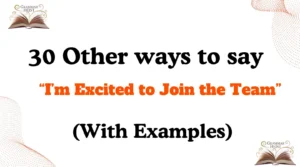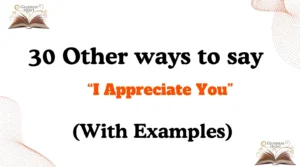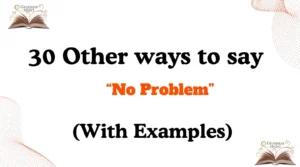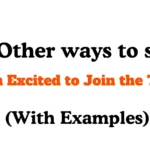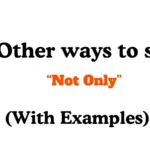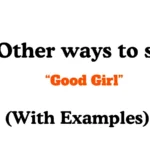When we talk about the future, especially in a professional or personal setting, how we express “moving forward” can impact the tone and direction of a conversation. Choosing the right phrase can make the message feel more engaging, motivational, and even more personal. Instead of using the standard phrase “moving forward,” consider these 30 alternatives to add warmth, clarity, or professionalism to your communication.
Is It Professional/Polite to Say “Moving Forward”?
“Moving forward” is a common phrase used in both professional and personal contexts to indicate progress or a shift towards the future. It’s polite and professional, but it can sometimes sound overused or vague. By using different expressions, you can better capture your intent and convey your message in a way that resonates with the recipient.
Pros and Cons
Pros:
- Clear indication of future action.
- Works well in professional or business settings.
- Easy to understand and widely accepted.
Cons:
- Can be overused or feel repetitive.
- Might come across as impersonal or too formal.
- Doesn’t always convey a sense of enthusiasm or warmth.
Synonyms & Alternatives for “Moving Forward”
- “Going ahead”
- “From now on”
- “In the future”
- “Looking ahead”
- “As we proceed”
How to Say It in Different Ways
- Strategic: “Looking ahead, we’ll focus on improving efficiency.”
- Professional: “As we proceed, let’s keep communication clear.”
- Optimistic: “Going forward, I’m confident we’ll achieve great results.”
- Casual: “From here on out, things are only getting better.”
- Reflective: “Now that we’ve learned from this, let’s move ahead wisely.”
Professional Ways to Say “Moving Forward”
- “As we progress, let’s maintain this level of collaboration.”
- “Going ahead, we’ll implement the new strategy.”
- “Looking forward, our main priority will be customer satisfaction.”
- “From this point onward, we’ll follow the updated process.”
- “To continue our success, we’ll build on what we’ve started.”
Formal Ways to Say “Moving Forward”
- “Henceforth, the following measures will be implemented.”
- “Subsequently, we aim to improve our workflow.”
- “From this juncture, our focus will shift to the next phase.”
- “In the forthcoming stages, we shall refine our approach.”
- “Hereafter, we intend to adhere to the updated guidelines.”
Informal Ways to Say “Moving Forward”
- “From here on out, let’s keep it simple.”
- “Let’s take things one step at a time.”
- “So, what’s next?”
- “Time to keep things rolling.”
- “Let’s move on and make it even better.”
What “Moving Forward” Means
- It signals progress or transition toward a new stage or goal.
- Often used to close one topic and introduce the next.
- Shows focus on future improvement and a proactive mindset.
- Common in business, meetings, and project updates.
- Encourages momentum and positive direction after reflection.
How to Respond to “Moving Forward”
- “Agreed, let’s put that plan into action.”
- “Sounds good — I’m ready for the next steps.”
- “I’m on board with that approach.”
- “Let’s make sure we follow through.”
- “Absolutely, I’m looking forward to what’s next.”
Synonyms For Moving Forward
- Looking Ahead
- As We Proceed
- From Here On
- Going Forward
- In the Future
- As We Move Ahead
- In the Coming Weeks
- In the Near Future
- From This Point On
- As Time Goes On
- In the Days Ahead
- With Time
- On the Horizon
- In the Works
- In Progress
- In Motion
- Looking Toward
- In the Near Term
- Afterward
- From Here
- As We Move Forward
- In the Long Run
- From Now On
- Moving On
- Looking Toward the Future
- In the Upcoming Period
- Looking to the Next Phase
- In the Process of
- As We Progress
- As We Continue
1. “Looking Ahead”
Scenario: When you want to talk about plans or ideas for the future.
Examples:
- “Looking ahead, we aim to streamline the process.”
- “Looking ahead, we’ll be focusing on innovation.”
- “Looking ahead, our goal is to improve customer service.”
Tone: Optimistic, forward-thinking.
Explanation: “Looking ahead” creates a sense of anticipation and focuses on future goals or planning.
2. “As We Proceed”
Scenario: When discussing the next steps or actions.
Examples:
- “As we proceed, please let me know if you have any questions.”
- “As we proceed with this project, we need to allocate more resources.”
- “As we proceed, I’ll keep you updated with any changes.”
Tone: Formal, thoughtful.
Explanation: This phrase offers a more careful, organized approach to future actions.
3. “From Here On”
Scenario: When indicating the beginning of future plans.
Examples:
- “From here on, we will be implementing the new changes.”
- “From here on, you’ll be working directly with the team.”
- “From here on, we’ll be focusing on expanding our outreach.”
Tone: Definitive, forward-looking.
Explanation: “From here on” signals a clear starting point for upcoming changes or actions.
4. “Going Forward”
Scenario: When you want to discuss upcoming actions or changes.
Examples:
- “Going forward, we’ll prioritize efficiency in every task.”
- “Going forward, I’ll be your main point of contact.”
- “Going forward, we plan to improve customer engagement.”
Tone: Professional, action-oriented.
Explanation: This is a straightforward alternative to “moving forward” that still emphasizes progression and future initiatives.
5. “In the Future”
Scenario: When talking about future plans or visions.
Examples:
- “In the future, we will be focusing more on sustainability.”
- “In the future, we see an opportunity for global expansion.”
- “In the future, we want to implement more inclusive practices.”
Tone: Visionary, strategic.
Explanation: “In the future” is simple but effective when outlining what lies ahead.
6. “As We Move Ahead”
Scenario: When focusing on upcoming steps or progress.
Examples:
- “As we move ahead, I’ll keep you informed of any developments.”
- “As we move ahead with this project, let’s keep collaboration in mind.”
- “As we move ahead, we should aim for greater efficiency.”
Tone: Action-oriented, confident.
Explanation: “Move ahead” signals active progress and momentum, making it feel like forward movement is already underway.
7. “In the Coming Weeks”
Scenario: When you want to specify a timeline for future actions.
Examples:
- “In the coming weeks, we’ll review the progress of the project.”
- “In the coming weeks, we’ll be launching the new product.”
- “In the coming weeks, we’ll finalize the details.”
Tone: Specific, anticipatory.
Explanation: This phrase adds a time frame to your statement, creating a sense of urgency and focus.
8. “In the Near Future”
Scenario: When you want to talk about short-term plans.
Examples:
- “In the near future, we plan to enhance our online services.”
- “In the near future, we’ll be offering new training opportunities.”
- “In the near future, our team will be expanding.”
Tone: Optimistic, realistic.
Explanation: This phrase is great for expressing more immediate goals or actions that are expected soon.
9. “From This Point On”
Scenario: When establishing new starting points or directions.
Examples:
- “From this point on, we will follow a more streamlined process.”
- “From this point on, you’ll be managing the project on your own.”
- “From this point on, we will prioritize customer experience.”
Tone: Determined, confident.
Explanation: This phrase indicates a change or a new path, often with a clear sense of commitment.
10. “As Time Goes On”
Scenario: When discussing progress or evolution over time.
Examples:
- “As time goes on, we’ll continue to improve the system.”
- “As time goes on, we’ll adjust to the changing market conditions.”
- “As time goes on, we’ll be able to scale the business further.”
Tone: Casual, long-term.
Explanation: “As time goes on” feels natural and gradual, implying a long-term process of development or change.
11. “In the Days Ahead”
Scenario: When outlining near-term plans or expectations.
Examples:
- “In the days ahead, we will start implementing the new strategy.”
- “In the days ahead, I’ll be checking in with you regularly.”
- “In the days ahead, you’ll receive more information about the project.”
Tone: Friendly, anticipatory.
Explanation: This phrase conveys a sense of the near future and emphasizes upcoming actions.
12. “With Time”
Scenario: When talking about gradual changes or progress.
Examples:
- “With time, we’ll see how effective this strategy is.”
- “With time, the improvements will become evident.”
- “With time, we’ll be able to address all the concerns.”
Tone: Reflective, gradual.
Explanation: “With time” suggests that the desired outcome will take place gradually, allowing for development and adjustment.
13. “On the Horizon”
Scenario: When something is coming up soon or is expected to happen.
Examples:
- “On the horizon, we have some exciting new opportunities.”
- “On the horizon, we anticipate growth in new markets.”
- “On the horizon, we see improvements in our operational processes.”
Tone: Exciting, optimistic.
Explanation: “On the horizon” evokes a sense of anticipation and possibility, suggesting that something good is coming soon.
14. “In the Works”
Scenario: When something is being planned or developed.
Examples:
- “We have some changes in the works that will improve efficiency.”
- “In the works is a new program designed to benefit the team.”
- “In the works are several initiatives that will enhance our service.”
Tone: Casual, action-oriented.
Explanation: This phrase conveys that something is actively being planned, built, or improved.
15. “In Progress”
Scenario: When you’re indicating that work or plans are actively underway.
Examples:
- “The project is in progress, and we should have an update soon.”
- “In progress is the next phase of development.”
- “In progress is the next step to improve operations.”
Tone: Active, current.
Explanation: “In progress” is direct and shows that work is actively happening or underway.
16. “In Motion”
Scenario: When you want to communicate that something is already moving forward.
Examples:
- “The new initiative is in motion, and we’re expecting positive results.”
- “The decision is in motion, and we’re waiting for confirmation.”
- “We’ve set the plan in motion, and work has already begun.”
Tone: Active, dynamic.
Explanation: “In motion” conveys that actions have already been set into play and things are happening.
17. “Looking Toward”
Scenario: When you want to focus on future goals or opportunities.
Examples:
- “Looking toward the future, we aim to expand globally.”
- “Looking toward the next quarter, we’ll focus on growth.”
- “Looking toward the future, we’re planning several new initiatives.”
Tone: Visionary, forward-thinking.
Explanation: “Looking toward” emphasizes that attention is already placed on what lies ahead.
18. “In the Near Term”
Scenario: When referring to actions that are expected to happen soon.
Examples:
- “In the near term, we’ll be prioritizing efficiency improvements.”
- “In the near term, we expect to complete phase one of the project.”
- “In the near term, we’re going to address the most critical issues.”
Tone: Strategic, specific.
Explanation: This phrase focuses on the immediate future, often in the context of business planning or problem-solving.
19. “Afterward”
Scenario: When referring to actions that will happen following something else.
Examples:
- “Afterward, we’ll schedule the next meeting.”
- “Afterward, we will begin the implementation phase.”
- “Afterward, we can move on to the next stage of development.”
Tone: Sequential, logical.
Explanation: “Afterward” places focus on the sequence of events, indicating that action will follow something else.
20. “From Here”
Scenario: When indicating where to begin or what to do next.
Examples:
- “From here, we’ll move forward with the plan.”
- “From here, we’ll begin drafting the next proposal.”
- “From here, we’ll take the necessary next steps.”
Tone: Strategic, clear.
Explanation: This phrase gives clarity on the next steps, emphasizing the path from the current point onward.
21. “As We Move Forward”
Scenario: When you want to indicate that actions or plans will continue to progress.
Examples:
- “As we move forward, we’ll continue to optimize our workflow.”
- “As we move forward with the project, we expect some challenges.”
- “As we move forward, it’s important that we stay aligned on goals.”
Tone: Professional, optimistic.
Explanation: This phrase emphasizes the ongoing nature of progress and highlights the need for consistent effort.
22. “In the Long Run”
Scenario: When referring to outcomes or goals that will take time to achieve.
Examples:
- “In the long run, this decision will benefit the company.”
- “In the long run, we’ll see a return on our investment.”
- “In the long run, this approach will improve customer satisfaction.”
Tone: Strategic, reflective.
Explanation: “In the long run” suggests a focus on long-term results and sustainable outcomes.
23. “From Now On”
Scenario: When you want to emphasize a change or shift in direction starting immediately.
Examples:
- “From now on, we’ll be using a new communication tool.”
- “From now on, all meetings will be held virtually.”
- “From now on, let’s prioritize teamwork over individual tasks.”
Tone: Authoritative, decisive.
Explanation: This phrase signals a clear break from the past and outlines immediate changes.
24. “Moving On”
Scenario: When you want to indicate progress or the next phase of something.
Examples:
- “Moving on, let’s focus on the next item on the agenda.”
- “Moving on, we’ll begin working on the next project.”
- “Moving on, it’s time to address the upcoming challenges.”
Tone: Casual, straightforward.
Explanation: “Moving on” keeps things simple and forward-focused, perfect for transitioning between topics or phases.
25. “Looking Toward the Future”
Scenario: When you want to express optimism and focus on future goals.
Examples:
- “Looking toward the future, we have a number of exciting opportunities.”
- “Looking toward the future, we see a path to greater success.”
- “Looking toward the future, we’re committed to continuous improvement.”
Tone: Optimistic, hopeful.
Explanation: This phrase evokes a sense of vision and ambition, emphasizing what is yet to come.
26. “In the Upcoming Period”
Scenario: When referring to near-term plans or upcoming actions.
Examples:
- “In the upcoming period, we’ll focus on enhancing user experience.”
- “In the upcoming period, we’ll be working on scaling the project.”
- “In the upcoming period, we’ll start rolling out the new updates.”
Tone: Professional, formal.
Explanation: This phrase gives a more formal tone, providing a specific time frame for upcoming activities.
27. “Looking to the Next Phase”
Scenario: When discussing the next stage of a process or project.
Examples:
- “Looking to the next phase, we’ll refine our strategies.”
- “Looking to the next phase, we plan to integrate new technologies.”
- “Looking to the next phase, we’ll expand our team.”
Tone: Forward-thinking, ambitious.
Explanation: “Next phase” indicates a clear progression to a new level or stage, often signaling growth or expansion.
28. “In the Process of”
Scenario: When referring to something that is currently underway or developing.
Examples:
- “We’re in the process of improving the user interface.”
- “In the process of scaling, we expect to encounter challenges.”
- “In the process of launching the new website, we’ll need feedback.”
Tone: Active, ongoing.
Explanation: This phrase communicates that something is actively being worked on and suggests ongoing progress.
29. “As We Progress”
Scenario: When talking about how things will evolve or move forward.
Examples:
- “As we progress, we’ll be able to refine our approach.”
- “As we progress with the project, we’ll make necessary adjustments.”
- “As we progress, we anticipate greater collaboration between teams.”
Tone: Professional, gradual.
Explanation: “Progress” conveys steady forward motion and an emphasis on gradual improvement or development.
30. “As We Continue”
Scenario: When referring to an ongoing process that will carry on into the future.
Examples:
- “As we continue, let’s stay aligned with the overall vision.”
- “As we continue, we’ll address any emerging concerns.”
- “As we continue to work on this, feel free to share your insights.”
Tone: Collaborative, supportive.
Explanation: This phrase keeps things moving while highlighting the importance of ongoing collaboration or effort.
Conclusion
Finding new and engaging ways to express “moving forward” is an excellent way to enhance your communication. By choosing phrases that feel more personal, professional, or thoughtful, you create a tone that resonates with your audience.
Whether you are working on a project, discussing future plans, or addressing upcoming goals, varying your language keeps your conversations fresh, clear, and meaningful. These alternatives not only help to avoid repetition but also allow you to express optimism, determination, and forward momentum in a way that feels intentional and caring.

Mia Rose is a skilled language expert with a deep passion for helping individuals master the art of writing and communication. With years of experience in the field, Marie brings a thoughtful and tailored approach to grammar, style, and language improvement. Her goal is to empower others to express themselves with clarity, precision, and confidence in every written word.


